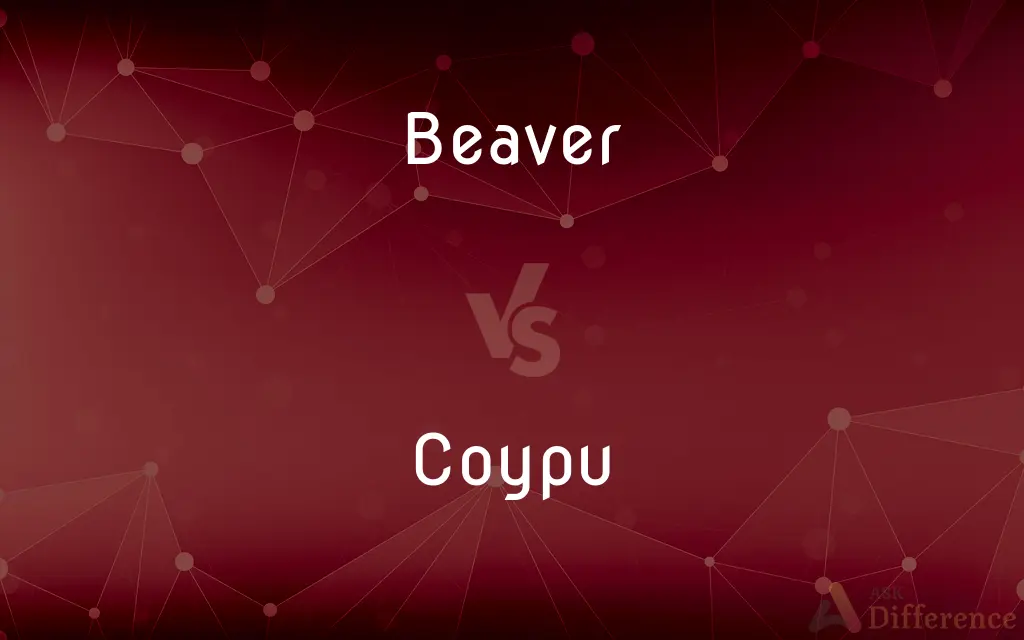Beaver vs. Coypu — What's the Difference?
By Urooj Arif & Maham Liaqat — Updated on March 26, 2024
Beavers are large, primarily nocturnal, semi-aquatic rodents known for building dams and lodges, while coypus (nutria) are smaller, invasive rodents with distinctive orange teeth, damaging wetlands by burrowing.

Difference Between Beaver and Coypu
Table of Contents
ADVERTISEMENT
Key Differences
Beavers, native to North America and Eurasia, are celebrated for their dam-building abilities, which create habitats that support diverse ecosystems. In contrast, coypus, originally from South America and introduced worldwide, are often considered pests for their destructive impact on wetlands and agriculture due to their aggressive burrowing and eating habits.
While beavers have a robust body, large flat tail, and webbed feet adapted for their aquatic lifestyle, coypus are identified by their smaller size, long, thin tail, and partially webbed hind feet, which suit their semi-aquatic nature but offer less proficiency in water compared to beavers.
Beavers are vegetarians, feeding mainly on tree bark, leaves, and aquatic plants, playing a crucial role in environmental engineering that benefits other species. Coypus, on the other hand, have a broader diet that includes aquatic plants, roots, and crops, contributing to significant ecological and agricultural damage.
The social structure of beavers is complex, with families living together in lodges they construct, which demonstrates advanced cooperative behavior and social bonding. Coypus tend to form less structured social groups, living in burrows along water bodies, and do not exhibit the same level of familial cooperation.
Beavers impact the environment positively by creating wetlands that support biodiversity, improve water quality, and reduce erosion. Conversely, coypus are detrimental to the ecosystems they invade, causing erosion, flooding, and displacement of native species due to their feeding and burrowing activities.
ADVERTISEMENT
Comparison Chart
Origin
North America and Eurasia
South America
Size
Larger, up to 60 pounds (27 kg)
Smaller, up to 20 pounds (9 kg)
Tail
Large, flat, and paddle-shaped
Long, thin, and round
Feet
Webbed, adapted for swimming
Partially webbed hind feet
Diet
Vegetarian, mainly tree bark and aquatic plants
Omnivorous, including aquatic plants and crops
Social Structure
Live in family groups in lodges
Form loose social groups, live in burrows
Environmental Impact
Create wetlands, supporting biodiversity
Damage wetlands, agricultural lands
Teeth
Typical rodent teeth
Distinctive orange teeth
Lifestyle
Nocturnal, semi-aquatic
Semi-aquatic, invasive species
Compare with Definitions
Beaver
Their diet consists mainly of tree bark and aquatic plants.
The beaver gnawed on the bark of a fallen tree.
Coypu
Their presence in ecosystems often leads to environmental damage.
The invasive coypu population caused significant erosion.
Beaver
A large, nocturnal, semi-aquatic rodent known for building dams and lodges.
The beaver used tree branches to construct its dam.
Coypu
A smaller, semi-aquatic rodent with distinctive orange teeth, considered invasive.
The coypu was seen burrowing into the riverbank.
Beaver
Beavers live in family groups within lodges they build.
A family of beavers was spotted near the river lodge.
Coypu
Nutria live in burrows along water bodies without structured social groups.
A group of coypus emerged from their riverbank burrows.
Beaver
They play a crucial role in creating and maintaining wetlands.
The beaver's dam created a new wetland habitat.
Coypu
They have a broad diet, including crops and aquatic plants.
Coypus have been damaging local crops by feeding at night.
Beaver
Beavers have a flat tail and webbed feet for swimming.
The beaver slapped its flat tail on the water as a warning.
Coypu
Coypus have long, thin tails and partially webbed hind feet.
The coypu used its webbed feet to paddle through the water.
Beaver
Beavers are large, semiaquatic rodents in the genus Castor native to the temperate Northern Hemisphere. There are two extant species: the North American beaver (Castor canadensis) and the Eurasian beaver (C. fiber).
Coypu
The coypu (from Spanish coipú, from Mapudungun koypu; Myocastor coypus), also known as the nutria, is a large, herbivorous, semiaquatic rodent. Classified for a long time as the only member of the family Myocastoridae, Myocastor is now included within Echimyidae, the family of the spiny rats.
Beaver
Either of two large semiaquatic rodents, Castor canadensis of North America or C. fiber of Eurasia, having thick brown fur, webbed hind feet, a broad flat tail, and sharp incisors used for gnawing bark and felling trees, with which they construct dams and underwater lodges.
Coypu
See nutria.
Beaver
The fur of a beaver.
Coypu
A large, crepuscular, semiaquatic rodent (Myocastor coypus) resembling a large rat, having bright orange-yellow incisors, native to South America and introduced to Europe, Asia and North America, valued for its fur in eastern Europe and central Asia and considered a pest elsewhere.
Beaver
A top hat originally made of the underfur of a beaver.
Coypu
A South American rodent (Myopotamus coypus), allied to the beaver. It produces a valuable fur called nutria.
Beaver
A napped wool fabric, similar to felt, used for outer garments.
Coypu
Aquatic South American rodent resembling a small beaver; bred for its fur
Beaver
Vulgar Slang The female genitals.
Beaver
Offensive Slang A woman or girl.
Beaver
The visor on a helmet.
Beaver
Of or relating to a beaver or beavers
Beaver fur.
A beaver hat.
Beaver
Constructed by beavers
Beaver dams.
Beaver
To work diligently and energetically.
Beaver
To spot a beard in a game of beaver.
Beaver
To work hard.
Beaver
To cut a continuous ring around a tree that one is felling.
Beaver
(backgammon) After being doubled, to immediately double the stakes again, a move that keeps the doubling cube on one’s own side of the board.
Beaver
(countable) A semiaquatic rodent of the genus Castor, having a wide, flat tail and webbed feet.
Beaver
The fur of the beaver.
Beaver
(countable) A hat, of various shapes, made from a felted beaver fur (or later of silk), fashionable in Europe between 1550 and 1850.
Beaver
(North American) Beaver pelts as an article of exchange or as a standard of value.
Beaver
Beaver cloth, a heavy felted woollen cloth, used chiefly for making overcoats.
Beaver
A brown colour, like that of a beaver.
Beaver
A move in response to being doubled, in which one immediately doubles the stakes again, keeping the doubling cube on one’s own side of the board.
Beaver
Senseid|en|member of the youngest wing of the Scout movement}} {{alternative case form of Beaver.
Beaver
Senseid|en|part of a helmet}} {{alternative spelling of bevor.
Beaver
An amphibious rodent, of the genus Castor.
Beaver
The fur of the beaver.
Beaver
A hat, formerly made of the fur of the beaver, but now usually of silk.
A brown beaver slouched over his eyes.
Beaver
Beaver cloth, a heavy felted woolen cloth, used chiefly for making overcoats.
Beaver
A man's beard.
Beaver
The hair on a woman's pubic area; - vulgar.
Beaver
A woman; - vulgar and offensive.
Beaver
A person who works enthusiastically and diligently; - used especially in the phrase eager beaver.
Beaver
The soft brown fur of the beaver
Beaver
A full beard
Beaver
A man's hat with a tall crown; usually covered with beaver or silk
Beaver
A movable piece of armor on a medieval helmet used to protect the lower face
Beaver
A hat made of beaver fur or similar material
Beaver
Large semiaquatic rodent with webbed hind feet and a broad flat tail; construct complex dams and underwater lodges
Beaver
Work hard on something
Common Curiosities
Can beavers and coypus coexist in the same habitat?
While they may share similar habitats, their impact on the environment is vastly different, often leading to conflicts over resources.
What is the primary difference between beavers and coypus?
Beavers are known for their ecological benefits and dam-building, while coypus are invasive and cause environmental damage.
Are beavers larger than coypus?
Yes, beavers are generally larger and heavier than coypus.
Do beavers and coypus have similar diets?
While both are semi-aquatic and consume aquatic vegetation, beavers are more selective, focusing on tree bark and aquatic plants, whereas coypus have a broader diet that includes crops.
What are the distinctive physical features of a coypu?
Coypus are noted for their smaller size, long thin tail, partially webbed feet, and distinctive orange teeth.
Why do beavers build dams?
Beavers build dams to create deep, still water for protection against predators and to access food during winter.
Why are coypus considered invasive?
Coypus are considered invasive due to their destructive feeding and burrowing habits, which damage wetlands and agricultural areas.
Are there any control measures for coypu populations?
Yes, various methods including trapping, fencing, and habitat management are used to control coypu populations.
How do coypus damage ecosystems?
Coypus damage ecosystems by burrowing into riverbanks, causing erosion and flooding, and by overgrazing on vegetation.
Is there any benefit to having coypus in an ecosystem?
While coypus can contribute to the control of certain aquatic plants, their overall impact is largely negative.
How do beavers impact their environment positively?
Beavers create wetlands that support biodiversity, improve water quality, and help control erosion.
What role do beavers play in water quality improvement?
Beaver dams filter and store water, reducing sediment and pollutants, which improves water quality.
How do coypus affect agricultural lands?
Coypus eat crops and vegetation, leading to significant agricultural damage and economic losses.
What measures are taken to protect beaver populations?
Conservation efforts include habitat restoration, legal protection, and promoting the ecological benefits of beaver activity.
Can the presence of beavers help control coypu populations?
There's no direct relationship, but by altering habitats, beavers might indirectly affect coypu populations through changes in available resources.
Share Your Discovery

Previous Comparison
Supplement vs. Addendum
Next Comparison
Diversity vs. MulticulturalismAuthor Spotlight
Written by
Urooj ArifUrooj is a skilled content writer at Ask Difference, known for her exceptional ability to simplify complex topics into engaging and informative content. With a passion for research and a flair for clear, concise writing, she consistently delivers articles that resonate with our diverse audience.
Co-written by
Maham Liaqat













































